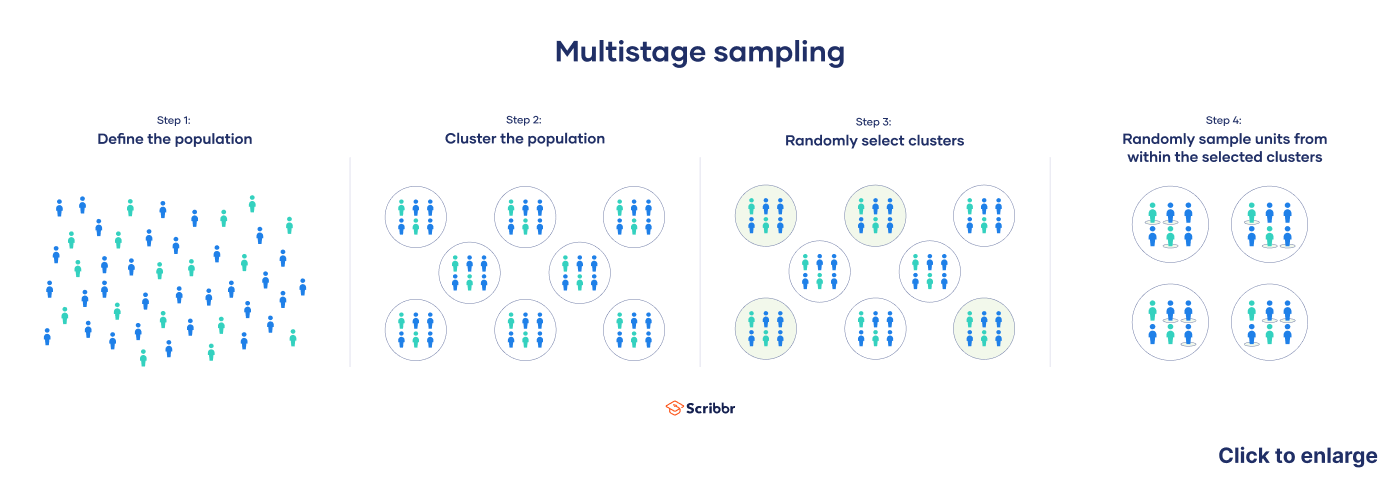Multistage Sampling | An Introductory Guide with Examples
In multistage sampling, or multistage cluster sampling, you draw a sample from a population using smaller and smaller groups (units) at each stage. It’s often used to collect data from a large, geographically diverse group of people in national surveys.
Single-stage vs multistage sampling
In single-stage sampling, you divide a population into units (e.g., households or individuals) and select a sample directly by collecting data from everyone in the selected units.
In multistage sampling, you divide the population into smaller and smaller groupings to create a sample using several steps. You can take advantage of hierarchical groupings (e.g., from county to city to neighbourhood) to create a sample that’s less expensive and time-consuming to collect data from.
You can use either probability or non-probability sampling methods in single-stage and multi-stage sampling. But for external validity, or generalisability, it’s best to use probability sampling methods, which allow for stronger statistical inferences.
Single-stage sampling
In single-stage probability sampling, you start with a sampling frame, which is a list of every member in the entire population. It should be as complete as possible, so that your sample accurately reflects your population.
The sampling frame for your study is a list of all teenage students registered at schools within the county. To obtain this list, you can reach out to the county education department or to each school individually to request a list of students.
You can use simple random, systematic, stratified, or cluster sampling methods to select a probability sample from your sampling frame.
Cluster vs stratified sampling
In cluster sampling and stratified sampling, you divide up your population into groups that are mutually exclusive and exhaustive.
In cluster sampling, the population is divided into clusters, which are usually based on geography (e.g., cities or counties) or organisation (e.g., schools or universities). In single-stage cluster sampling, you randomly select some of the clusters for your sample and collect data from everyone within those clusters in one stage.
In stratified sampling, the population is divided into strata, which are often based on demographic characteristics such as race, gender, or socioeconomic status. Every unit or member of the population is placed in one stratum. You select some members from each stratum so that all groups are represented in your sample.
Multistage sampling often involves a combination of cluster and stratified sampling.
Multistage sampling
Multistage sampling is often considered an extended version of cluster sampling.
In multistage sampling, you divide the population into clusters and select some clusters at the first stage. At each subsequent stage, you further divide up those selected clusters into smaller clusters, and repeat the process until you get to the last step. At the last step, you only select some members of each cluster for your sample.
Like in single-stage sampling, you start by defining your target population. But in multistage sampling, you don’t need a sampling frame that lists every member of the population. That’s why this method is useful for collecting data from large, dispersed populations.
If you’re unable to access a complete sampling frame, you can’t use single-stage probability sampling from the whole population. In addition, collecting data from a sample of individuals across the county would be very difficult, costly, and time-intensive.
Instead, you decide to use a multistage sampling method to collect a representative sample of participants.
In multistage sampling, you always go from higher-level to lower-level clusters at each stage. The clusters are often referred to as sampling units.
At the first stage, you divide up the population into clusters and select some of them: these are your primary sampling units (PSUs).
At the second stage, you divide up your PSUs into further clusters, and select some of them as your secondary sampling units (SSUs).
You can end at the second stage, or continue this process with as many stages as you need. In the last stage, you’ll get to your final sample of ultimate sampling units (USUs).
In the second stage, you list all schools within those school districts. You select 10 schools from each district as your SSUs.
In the third stage, you obtain a list of all students within those schools. You select 50 students from every school as your USUs, and collect data from those students.
For a probability sample, you must use a probability sampling technique to select clusters at every stage. But you can mix it up by using simple random, systemic, or stratified methods to select units at each stage based on what’s relevant and applicable to your study.
First stage: Primary sampling units
At the first stage, like in cluster sampling, you’ll divide your population into clusters that are mutually exclusive and exhaustive.
Then, you’ll choose some of your clusters to be your primary sampling units, ideally using a probability sampling method. You can use any of the single-stage sampling methods to select your PSUs.
Large-scale surveys often use a combination of cluster and stratified sampling at the first stage to help ensure that the units are representative of the larger population. This is called a stratified multistage sample.
You begin by stratifying your clusters at the first stage. After stratification, you select clusters using a probability sampling method.
You make a list of all school districts within the county. Each school district is a unit, or cluster. You can easily create a list of school districts because it’s publicly available information, unlike a list of your target population of students in the county.
You stratify the school districts by area type: urban, suburban, and rural regions. You want to ensure that all three area types are represented in your sample.
For each stratum, you list the school districts that fall into that category. Then, you use simple random sampling to select 5 school districts from within each stratum. These 15 school districts are your primary sampling units.
Single-stage cluster sampling ends at this point because you would collect data from everyone within your selected clusters (the PSUs). This is often infeasible in real life, so multistage sampling goes further by sampling from within each cluster or unit to create new units.
Second stage: Secondary sampling units
At the second stage, you divide up your PSUs to get to smaller sampling units. You’ll select only some of these smaller units from within each selected PSU: these are your secondary sampling units (SSUs).
You use a simple random sampling method to select 10 schools from each school district. These are your secondary sampling units.
If you end your sampling at this point, it’s called two-stage or double-stage sampling. This would mean collecting data from everyone in your secondary sampling units: all students in the selected schools.
It’s optional to continue the process by adding more stages, but it can often make the research process simpler.
Final stage: Ultimate sampling units
You can keep repeating the process of dividing up each sampling unit further and selecting a few of them for the next stage. At the final stage, you end with your ultimate sampling units.
These students are your ultimate sampling units – they form final sample that you will collect data from.
Advantages and disadvantages
Multistage sampling is effective and flexible with large samples, but it may be difficult to ensure your sample is representative of the population.
Advantages
- You don’t need to start with a sampling frame of your target population.
- Compared to a simple random sample, it’s relatively inexpensive and effective when you have a large or geographically dispersed population.
- It’s flexible – you can vary sampling methods between stages based on what’s appropriate or feasible.
Disadvantages
- Compared to simple random samples, you’ll need a larger sample size for a multistage sample to achieve the same statistical inference properties.
- The best choice of sampling method at each stage is very subjective, so you’ll need clear reasoning for your decision.
- It can lead to unrepresentative samples because large sections of populations may not be selected for sampling.
Frequently asked questions about multistage sampling
Cite this Scribbr article
If you want to cite this source, you can copy and paste the citation or click the ‘Cite this Scribbr article’ button to automatically add the citation to our free Reference Generator.
Bhandari, P. (2023, January 20). Multistage Sampling | An Introductory Guide with Examples. Scribbr. Retrieved 28 July 2025, from https://www.scribbr.co.uk/research-methods/multistage-sampling-method/

